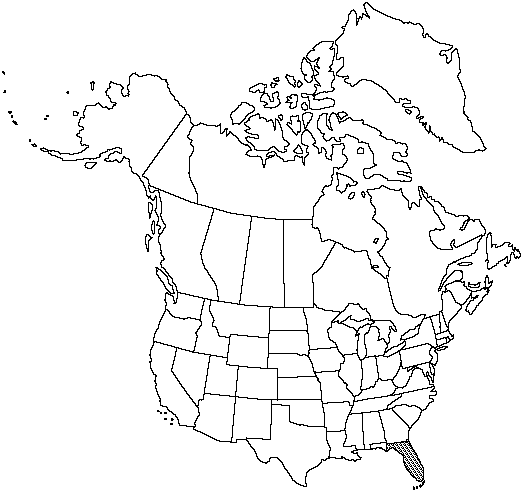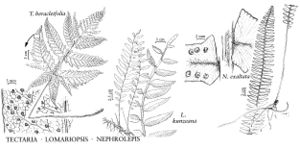Nephrolepis exaltata
Gen. Fil. plate 3. 1834.
Stem scales spreading, concolored. Tubers absent. Leaves 4–15 × 0.5–1.2 dm. Petiole 0.2–4 dm, sparsely to moderately scaly; scales spreading, pale-brown to reddish-brown, concolored. Blade glabrous, sparsely to moderately scaly abaxially near costae and adaxially. Rachis 2.4–16.3 dm, points of pinna attachment 7.3–21 mm apart; scales moderately spaced, pale to dark-brown, essentially concolored or margin indistinctly paler; hairs absent. Central pinnae deltate-oblong, slightly to distinctly falcate, 2.3–7.4 × 0.6–1.8 cm, base truncate to truncate-auriculate or auriculate, occasionally overlapping rachis, acroscopic lobe deltate to acute, margins serrulate, apex acute to deltate; costae adaxially glabrous. Indusia reniform to horseshoe-shaped, attached at narrow or broad sinus, 1–1.7 mm wide.
Habitat: Terrestrial or epiphytic in forested to open habitats, most often as an epiphyte
Elevation: 0 m
Distribution

Fla., West Indies, Pacific Islands in scattered locations.
Discussion
Nephrolepis exaltata is occasionally found farther north in the flora, but only as an escape from cultivation. Nephrolepis exaltata is usually confused with N. cordifolia when sterile; the latter species can be distinguished by its distinctly bicolored, adaxial rachis scales. These bicolored scales will distinguish N. cordifolia from all of the other species, even in the absence of other key features.
Selected References
None.
